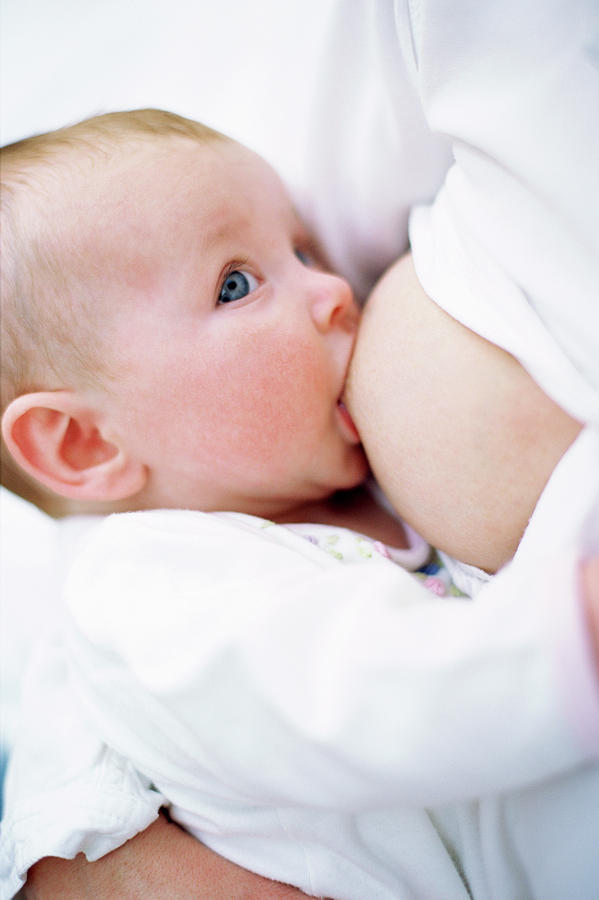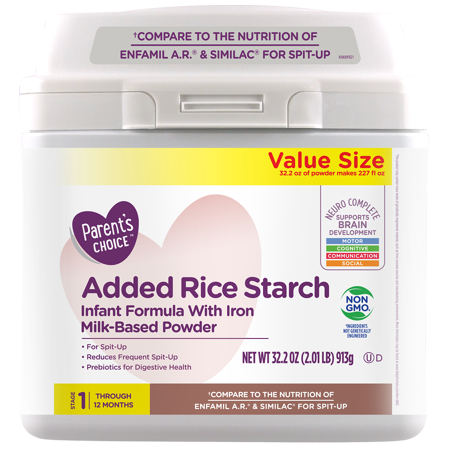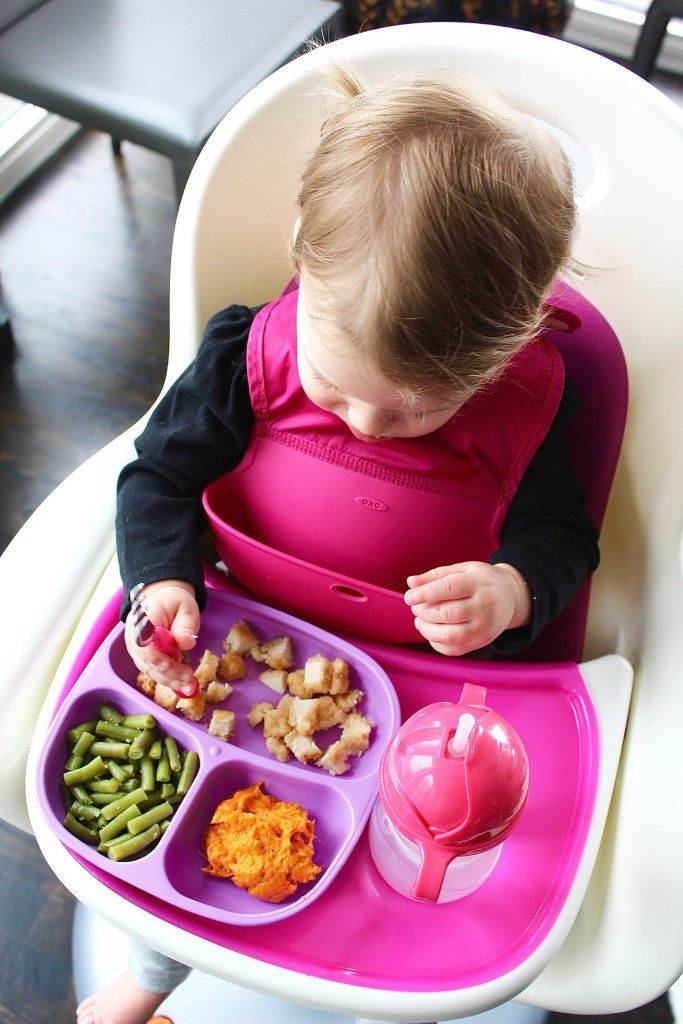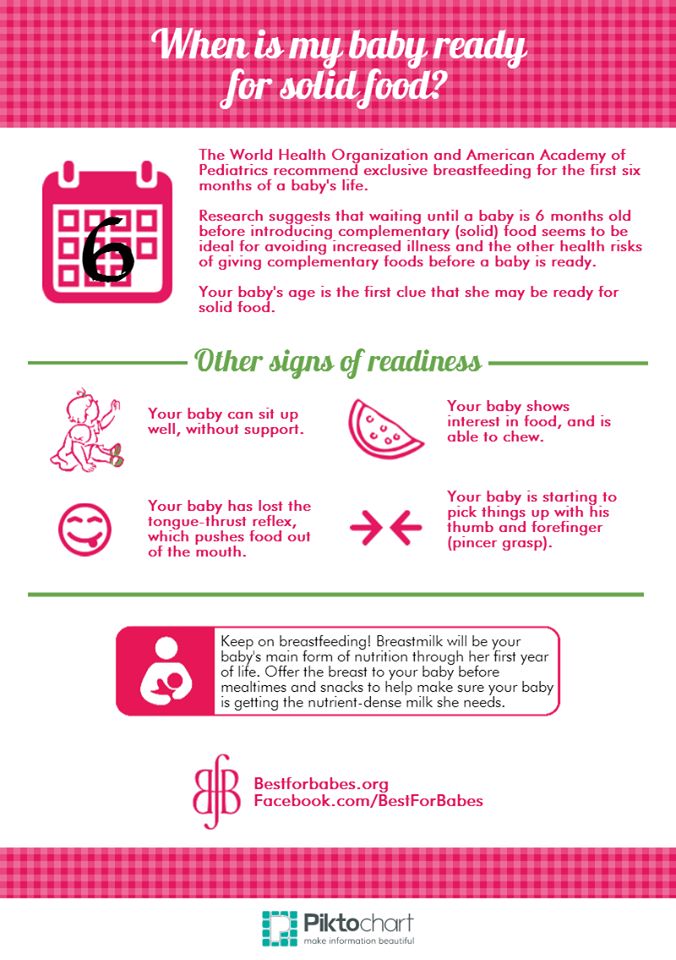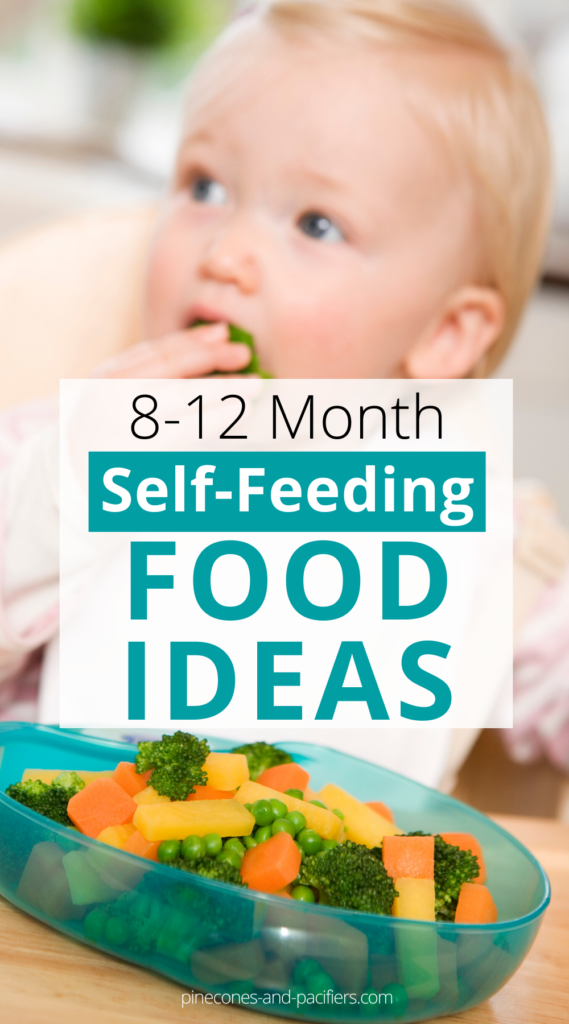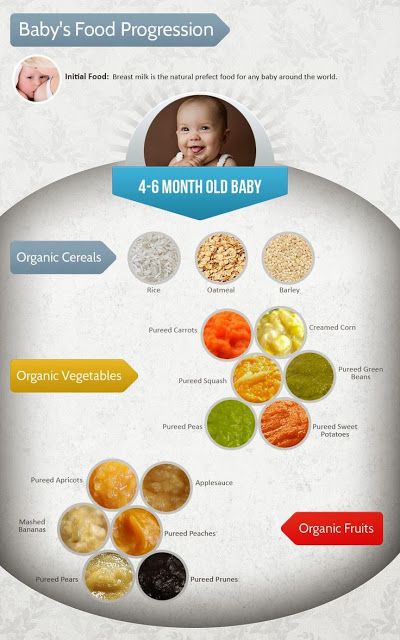Making pureed meat baby food
Basic Beef Baby Food Puree (6+ Months)
This homemade Basic Beef Baby Food is a great addition to your baby’s favorite purees for extra protein and flavor! It’s an incredibly simple recipe with big flavor and nutrition! It’s perfect as a Stage One Baby Food – 4-6+ months.
Medically reviewed and co-written by Jamie Johnson, Registered Dietitian Nutritionist (RDN), and Lauren Braaten, Pediatric Occupational Therapist (OT).
Beef Baby FoodBeef, it’s what’s for baby’s dinner! Beef puree, that is. 😉
This beef puree is loaded with so many great nutrients that your baby needs in order to thrive – protein, iron, calcium and folate.
And while it may seem counter-intuitive and perhaps weird (or at least it did to me), beef puree 🥩 is a great first food for your baby.
Just because it’s a nutrient-dense puree doesn’t mean your baby needs bowls upon bowls of it. Since beef puree has a somewhat intense flavor, a few spoonfuls added to your baby’s favorite veggie or fruit puree should be enough.
Is it your first time making homemade baby food? If you answered yes, then I suggest you start this journey by reading my in-depth Guide on How to Make Homemade Baby Food. The detailed article goes over all the essential information such as the best cooking tools to have on hand, safe storage, knowing when your baby is ready for solids, introducing purees, making the best first foods for baby, and more! You can also check out my best-selling cookbook for even more information and recipes.
Beef Puree Video
Watch this video to see how easy it is to make your baby homemade Beef Puree!
Reasons to Love this Beef Puree- simple yet flavorful
- packed with protein
- great to add to any other fruit or veggie puree that baby loves
- baby food for 4-6 months and up
- stage 1 baby food
- freezer-friendly
- homemade
Make sure to read the recipe card below for full ingredients and instructions!
- Beef: Since beef is the star of the show in this puree, we are going to start with a good piece of meat.
 We are going to use 8oz of chuck stew meat or cubed sirloin beef. You can also easily scale up this recipe if you want more than 12 ounces of baby food.
We are going to use 8oz of chuck stew meat or cubed sirloin beef. You can also easily scale up this recipe if you want more than 12 ounces of baby food. - Broth: To get that rich, deep beef flavor, we will cook our beef in beef broth. I recommend using a low-sodium, sodium-free, or free-range beef bone broth for this recipe. You can also use any of those variations above with a vegetable broth as well. If you don’t have any of those on hand, you can use water.
- Oregano: We are adding dried oregano to give the puree a little more complex taste. This can easily be omitted if you prefer or you can substitute in dried parsley, basil, rosemary, thyme or cilantro.
Grass-Fed Beef: I recommend using grass-fed beef for this recipe, if possible. Grass-fed beef will have more healthy fats, more free Omega-3 fatty acids (healthy fats), vitamins A, E, and B as well as more antioxidants.
Health Benefits of Beef
- Protein: Beef is an excellent source of protein, which is essential for proper growth and development of all organ systems and maintaining and repairing tissues.
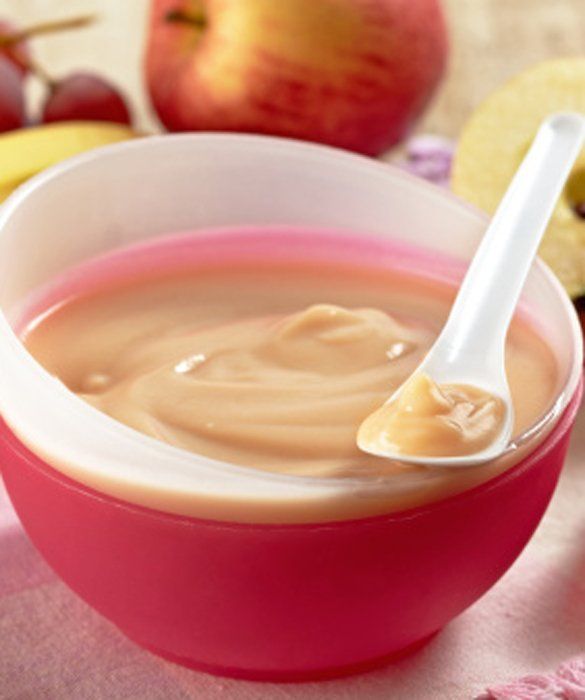 It is considered a complete protein, meaning it has all of the amino acids that are needed to make protein.
It is considered a complete protein, meaning it has all of the amino acids that are needed to make protein. - Iron: Beef is a good source of iron, needed for making red blood cells, neurodevelopment and preventing iron deficiency anemia, and zinc, needed for growth and development and supporting the immune system.
- B12: Beef is also high in B12, which is essential for brain development and healthy red blood cells.
- Choline: can also be found in beef, which is also important for brain growth and development.
- Boil: In a medium saucepan, bring the cubed beef, broth, and oregano to a boil over medium heat.
- Simmer: Turn the heat down to low and cover the saucepan. Simmer for 15-20 minutes or until the beef is just cooked through. Let it cool slightly.
- Puree: Using a slotted spoon, transfer the beef to a blender or food processor and puree until you reach your desired consistency, adding broth in 1/4 cup increments if needed.

- Eat: Serve to your baby plain or added into another puree.
- Freeze: Store a small portion in the fridge and freeze the rest for another meal.
These tools will make it a lot easier for you to make this healthy Beef Puree. For more of my favorite kitchen tools make sure to check out my shop.
- Saucepans
- Blender or Food Processor
- Freezer Tray
- Storage Containers for Fridge
- Stasher Bag
- bib with catch pocket
- Saucepans
Frequently Asked Questions
When can baby eat beef puree?
Babies can have beef as one of their first foods. When a baby can start on solids is determined by their own rate of development, which generally comes between 4-6 months of age. Some of the developmental milestones babies need to reach in order to start solids include: if your baby has solid control of their head and neck, if your baby has doubled in weight, and if your baby is reaching for or opening their mouth when you eat (see my guide here). Before you start your baby on purees, you should consult with your pediatrician to make sure your child is developmentally ready.
Before you start your baby on purees, you should consult with your pediatrician to make sure your child is developmentally ready.
Can beef be baby’s first food?
Yes, beef can 100% be baby’s first food if you want it to be. It is recommended to wait to introduce the top eight allergen foods to baby once a few other well tolerated foods have been introduced, but otherwise foods can be introduced in any order so choose whatever you are most excited for baby to have.
Is beef a common allergen for baby?
No, beef is not a common allergen, however, as with any food, start with a small portion and be aware of any signs that might be an allergic reaction after introducing it.
Does beef cause constipation for babies?
No, beef itself is not known to cause constipation in babies, however it won’t really help with constipation either since it lacks fiber. If baby is eating too much meat, it could replace fiber-rich foods, which could cause constipation.
You can store this puree in an airtight container in the fridge for up to 3 days.
FreezerThis puree can be frozen for up to 2 months.
- Spoon puree into a freezer storage container. Do not overfill.
- Place the lid on the storage container or cover with a piece of saran wrap, and label with the date and recipe name.
- Place the tray into the freezer and let it freeze completely — preferably overnight.
- Pop out the baby food cubes and place them in a ziplock baggie or stasher bag. Don’t forget to relabel the baggie or stasher bag for future reference.
Need more information on how to store your baby foods? Head over to my Best Baby Food Storage Containers – Plus 6 Tips on Freezing and Thawing post!
Label Tip: Don’t forget to label your purees before you place them in the fridge or freezer with the name of the puree and the date you made it. Take it from me; by the end of the week, you will completely forget what is in your freezer and how long it’s been there. 😉
Take it from me; by the end of the week, you will completely forget what is in your freezer and how long it’s been there. 😉
While this beef baby food is great by itself, it can be a little intense for some babies. I recommend mixing it into one of your baby’s favorite purees as an introduction to the rich taste of beef. Here are some great purees to mix with the beef puree:
- Apples
- Sweet Potato
- Pear
- Carrot
- Broccoli
- Pea
- Mango
PUREE FEEDING TIPS
- Follow your baby’s lead – when feeding purees from a spoon, sometimes there’s a tendency to keep offering bites past the point of your baby being full. Always follow your baby’s cues for when they are done eating. Turning away from the spoon, closing her mouth, or pushing food away are all signs that your baby is finished with the meal.
- Try adding a little seasoning or spice to purees – babies like flavor! Or consider changing the temperature of purees from time to time, to slightly warmed or slightly chilled.
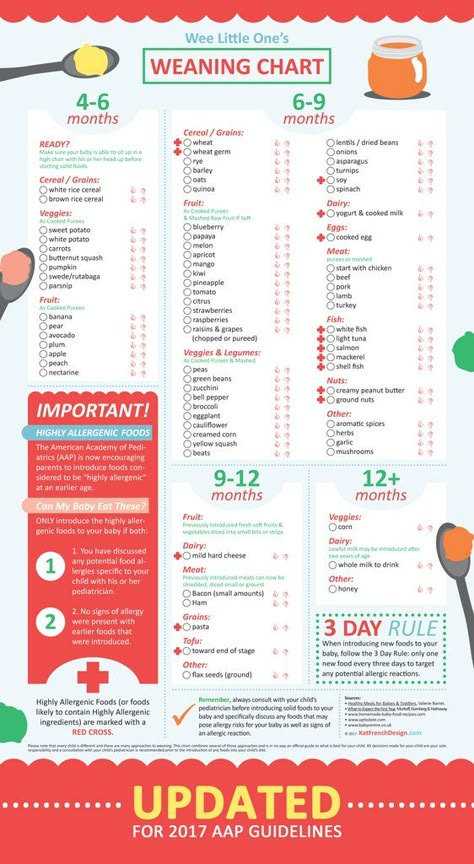 Varying these aspects adds to the sensory experience!
Varying these aspects adds to the sensory experience! - Throwing spoons is a common phase that all babies go through at one point or another. One of the best ways to handle spoon throwing is to ignore it and keep feeding your baby as usual (with an extra spoon you already have at the table). If your baby ends up also throwing back up spoons #2 AND #3, simply encourage your baby to eat with their hands until they appear to be finished with the meal. ***Give baby plenty of opportunities to practice putting items in and taking items out of containers outside of mealtimes.
- Use a Slotted Spoon: When transferring the cooked beef from the saucepan to the blender, make sure to use a slotted spoon so you don’t add too much broth into the puree from the start. You only want to add broth if needed while blending. I had to add a 1/4 cup of broth to the blender while I was pureeing this beef.
- Reheat Gently: If you are freezing some of this beef puree, reheat it in 20-second intervals.
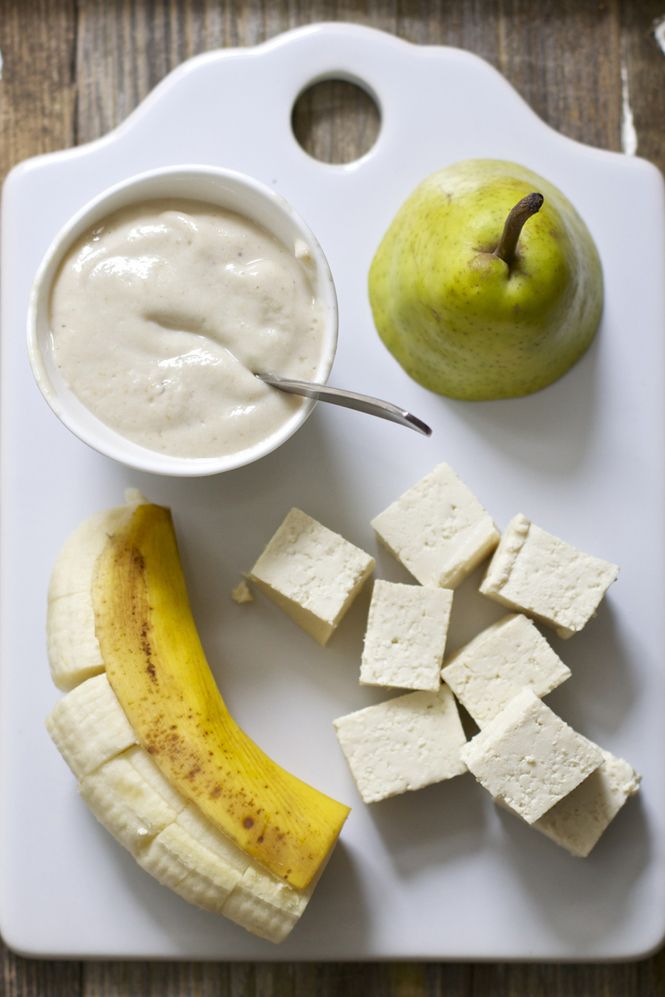 You don’t want to recook the beef.
You don’t want to recook the beef.
- 8 ounce beef chuck stew meat, or cubed sirloin beef
- 2 cups beef or vegetable broth, low or no sodium
- 1 tsp dried oregano
Boil: In a medium saucepan, bring beef, broth and oregano to a boil over medium heat. Turn to low and simmer for 15-20 minutes or until beef is cooked all the way through. Let cool slightly.
Transfer: Using a slotted spoon, transfer the beef to a blender or food processor, reserve broth.
Puree: starting on low and working your way up to high-speed, puree the beef until you reach your desired consistency, adding in broth in 1/4 cup increments if needed.
 I had to add in just 1/4 cup of broth to get the consistency seen in this photo.
I had to add in just 1/4 cup of broth to get the consistency seen in this photo.Eat: serve to baby plain or added into another puree.
Freeze: store a small portion in the fridge and freeze the rest for another meal.
Age: 4-6 months and up
Yield: 12 ounces
Storage: Fridge – store in an airtight container in the fridge for up to 4 days or in the freezer for up to 4 months.
Saucepan
Blender
Bumkins Baby Bowl
Freezer Tray
Did you make this recipe?
Tag @babyfoode on Instagram and hashtag it #babyfoode!
Pin Recipe Email a Friend
Basic Chicken Baby Food Recipe (6 months - Stage 1)
Home » Feeding Style » Baby Food Purees » Stage One » Basic Chicken Baby Food Recipe
This homemade Basic Chicken Baby Puree is a great addition to your baby’s favorite purees for extra protein and flavor! It’s an incredibly simple recipe with big flavor and nutrition! It’s perfect as a Stage One Baby Food or 6+ months.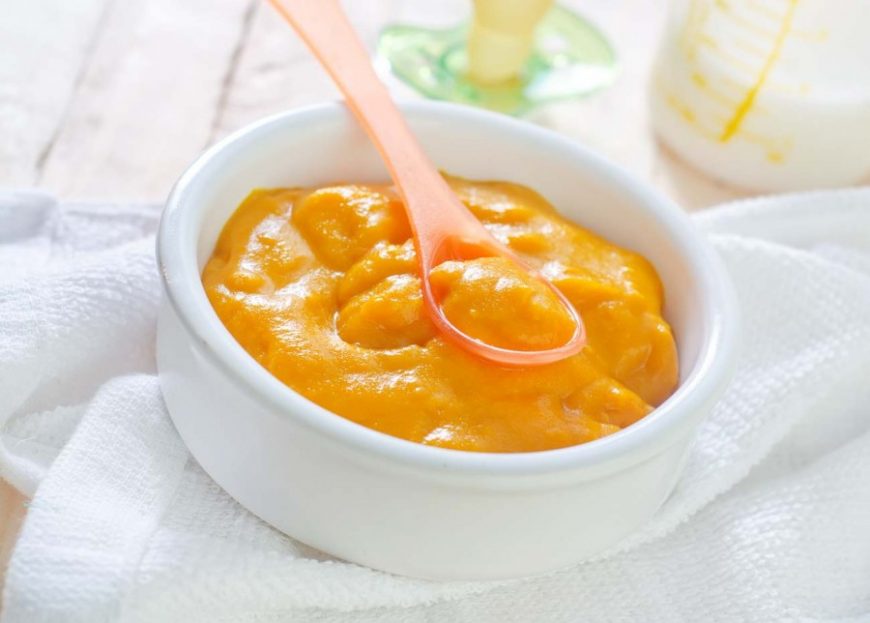
Medically reviewed by Jamie Johnson, Registered Dietitian Nutritionist (RDN), and Lauren Braaten, Pediatric Occupational Therapist (OT).
Chicken Baby PureeChicken 🍗 is full of essential vitamins, fat, and protein that your baby needs for their development. But pureed chicken for your baby? 🤔
I know, I know, I know. Pureed chicken for baby sounds… err.. gross. I get it! I was once thinking the same thing when I started my baby food journey because my only reference to a chicken puree for your baby was a self-stable store-bought chicken puree, which is 💯% not the best (trust me, I tasted them all).
And if I don’t want to eat it, I’m not going to serve it to my baby!
Baby food should be as good, if not better, than the food we eat.
But guys, without bias, this homemade chicken baby food puree is legit! It is gently cooked with chicken, earthy parsley, and a deep, rich broth. The key here is to cook the chicken just right — we do not want overcooked chicken.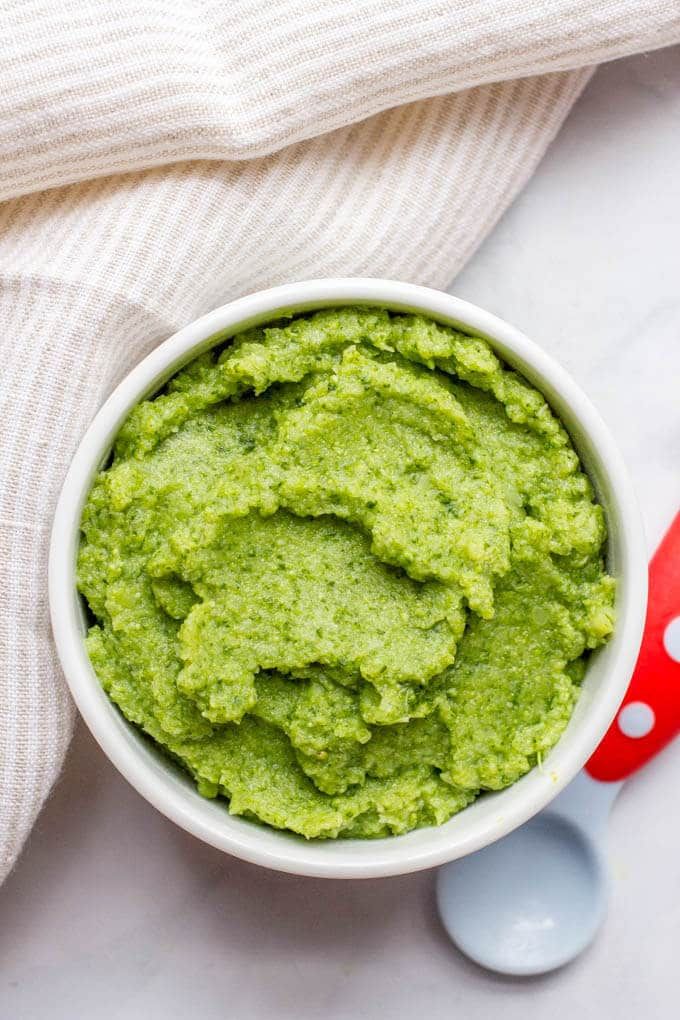 Then, we blend it up with a little extra broth, and you have yourself a creamy puree that tastes like a blended chicken noodle soup.
Then, we blend it up with a little extra broth, and you have yourself a creamy puree that tastes like a blended chicken noodle soup.
While some babies love this taste of a meat puree, others might find it a bit intense. That is totally okay. For starters, you can mix this chicken puree into any other fruit or veggie baby food you know your little one will love.
Is it your first time making homemade baby food? Then I suggest you start this journey by reading my in-depth Guide on How to Make Homemade Baby Food. The detailed guide goes over all the important information such as the best cooking tools to have on hand, safe storage, how to know when baby is ready for solids, how to introduce purees, the best first foods for baby, and more! You can also check out my best-selling cookbook for even more information and recipes!
Chicken Puree for Baby Video
Watch this video to see how easy this Chicken Puree recipe is to make!
Reasons to Love this Basic Chicken Puree- simple yet flavorful
- packed with protein
- great to add to any other fruit or veggie puree that baby loves
- baby food for 4 months and up
- stage 1 baby food
- freezer-friendly
- homemade
Make sure to read the recipe card below for the full list of ingredients and instructions!
- Chicken: As random as it may seem, chicken is the star of the show in this puree.
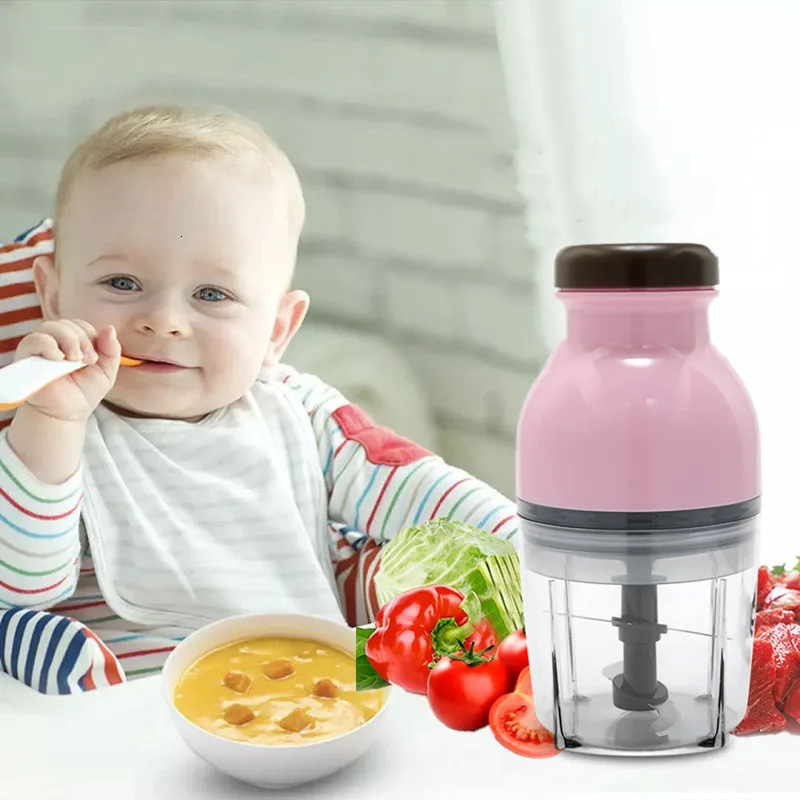 We are going to use an 8oz piece of boneless skinless chicken breast for this recipe. You can also use chicken thighs, but the puree will have a slightly different taste due to the higher fat content found in chicken thighs compared to breasts. You can also easily scale up this recipe if you want more than 12 ounces of baby food.
We are going to use an 8oz piece of boneless skinless chicken breast for this recipe. You can also use chicken thighs, but the puree will have a slightly different taste due to the higher fat content found in chicken thighs compared to breasts. You can also easily scale up this recipe if you want more than 12 ounces of baby food. - Broth: To get that rich, deep chicken flavor, we will cook our chicken in chicken broth. I recommend using a low-sodium, sodium-free, or free-range chicken bone broth for this recipe. You can also use any of those variations above with a vegetable broth as well. If you don’t have any of those on hand, you can use water.
- Parsley: We are adding dried parsley to give the puree a little more complex taste. This can easily be omitted if you prefer.
Organic Chicken: I highly recommend using organic chicken for this recipe, if possible. The organic chicken will be free of antibiotics, synthetic pesticides and will be fed a GMO-free diet. Pasture-raised is also recommended for more Omega-3 fatty acids (healthy fats).
Pasture-raised is also recommended for more Omega-3 fatty acids (healthy fats).
- High in protein for healthy muscle growth
- Contains iron, which is necessary to make hemoglobin, a protein in red blood cells
- Contains vitamin B12 for healthy nerve and blood cells and making DNA, and choline that helps promote brain development
- Boil: In a medium saucepan, bring the cubed chicken, broth, and parsley to a boil over medium heat.
- Simmer: Turn the heat down to low and cover the saucepan. Simmer it for 15-20 minutes or until the chicken is just cooked through. Let it cool slightly.
- Puree: Using a slotted spoon, transfer the chicken to a blender or food processor and puree until you reach your desired consistency, adding broth in 1/4 cup increments if needed.

- Eat: Serve to your baby plain or added into another puree.
- Freeze: Store a small portion in the fridge and freeze the rest for another meal.
- Blender or Food Processor
- Storage Containers for Fridge
- Freezer Tray
- Stasher Bag
- highchair
- suction bowl or baby bowl
- Bamboo Baby Spoon
- bib with catch pocket
WeeSprout Silicone Baby Food Freezer Tray
Our favorite freezer storage container for baby food! Made of 100% food-grade silicone and comes with a hard clip-on lid. Large 3oz sections with 2oz markings to make sure you have the right amount for your baby.
View Product
How to Store Chicken PureeRefrigeratorYou can store this puree in an airtight container in the fridge for up to 3 days.
FreezerThis puree can be frozen for up to 2 months.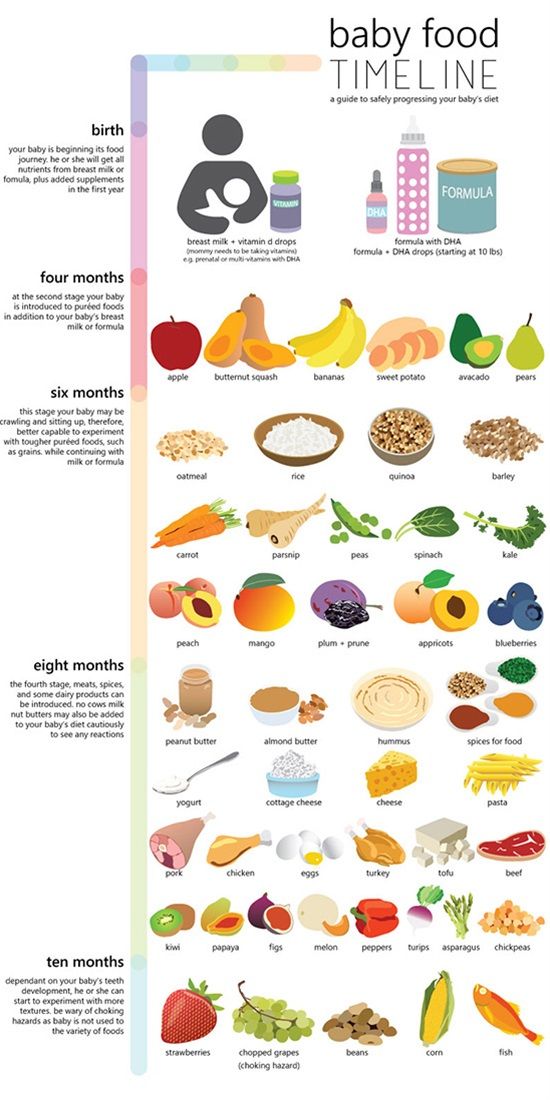
- Spoon puree into a freezer storage container (this is my favorite freezer storage container). Do not overfill.
- Place the lid on the storage container or cover with a piece of saran wrap, and label with the date and recipe name.
- Place the tray into the freezer and let it freeze completely — preferably overnight.
- Pop-out the baby food cubes and place them in a ziplock baggie or stasher bag. Don’t forget to relabel the baggie or stager bag for future reference.
Need more information on how to store your baby foods? Head over to my Best Baby Food Storage Containers – Plus 6 Tips on Freezing and Thawing post!
Label Tip: Don’t forget to label your purees before you place them in the fridge or freezer with the name of the puree and the date you made it. Take it from me; by the end of the week, you will completely forget what is in your freezer and how long it’s been there 😉
Frequently Asked Questions
When can baby eat chicken puree?
Baby can eat chicken as one of their first foods.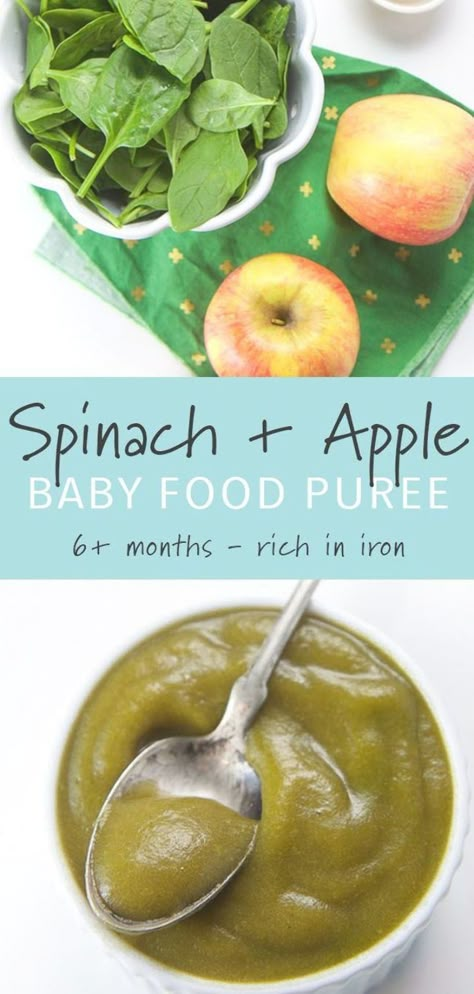 When a baby can start on solids is determined by their own rate of development, which generally comes between 4-6 months of age. Some of the developmental milestones babies need to reach in order to start solids include: if your baby has solid control of their head and neck, if your baby has doubled in weight, and if your baby is reaching for or opening their mouth when you eat (see my guide here). Before you start your baby on purees, you should consult with your pediatrician to make sure your child is developmentally ready for purees.
When a baby can start on solids is determined by their own rate of development, which generally comes between 4-6 months of age. Some of the developmental milestones babies need to reach in order to start solids include: if your baby has solid control of their head and neck, if your baby has doubled in weight, and if your baby is reaching for or opening their mouth when you eat (see my guide here). Before you start your baby on purees, you should consult with your pediatrician to make sure your child is developmentally ready for purees.
Can chicken be baby’s first food?
Chicken can 100% be your baby’s first food if you want it to be. It is recommended to wait to introduce the top eight allergen foods to your baby once a few other well-tolerated foods have been introduced, but otherwise, foods can be introduced in any order so choose whatever you are most excited for your baby to have.
Is chicken a common allergen for baby?
No, chicken is not a common allergen, however, as with any food, start with a small portion and be aware of any signs that might be an allergic reaction after introducing it.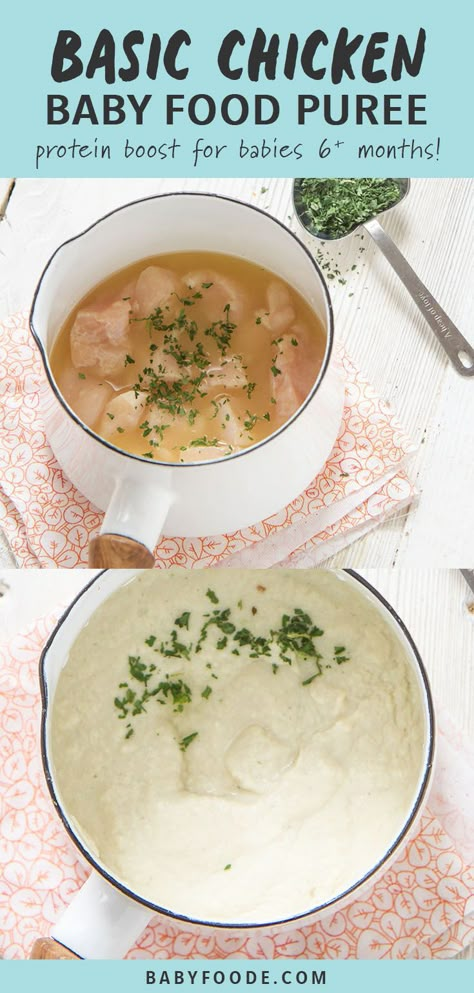
Does chicken cause constipation for babies?
No, chicken is not known to cause constipation in babies, however, it won’t really help with constipation either since it lacks fiber.
Can you freeze and then thaw the cooked chicken?
Yes, you can freeze and then thaw this chicken puree to serve to your baby. I would recommend you use fresh (not previously frozen) chicken and that you gently reheat it as to not make it too tough of a texture for your baby.
Great Chicken Combination PureesWhile this chicken baby food is great by itself, it can be a little intense for some babies. I recommend mixing it into one of your babe’s favorite purees as an introduction to the rich taste of chicken. Here are some great purees to mix with the chicken puree:
- Apples
- Sweet Potato
- Pear
- Carrot
- Broccoli
- Pea
- Mango
Recipe
Tips- Use a Slotted Spoon: When transferring the chicken from the saucepan to the blender, make sure to use a slotted spoon so you don’t add too much broth into the puree from the start.
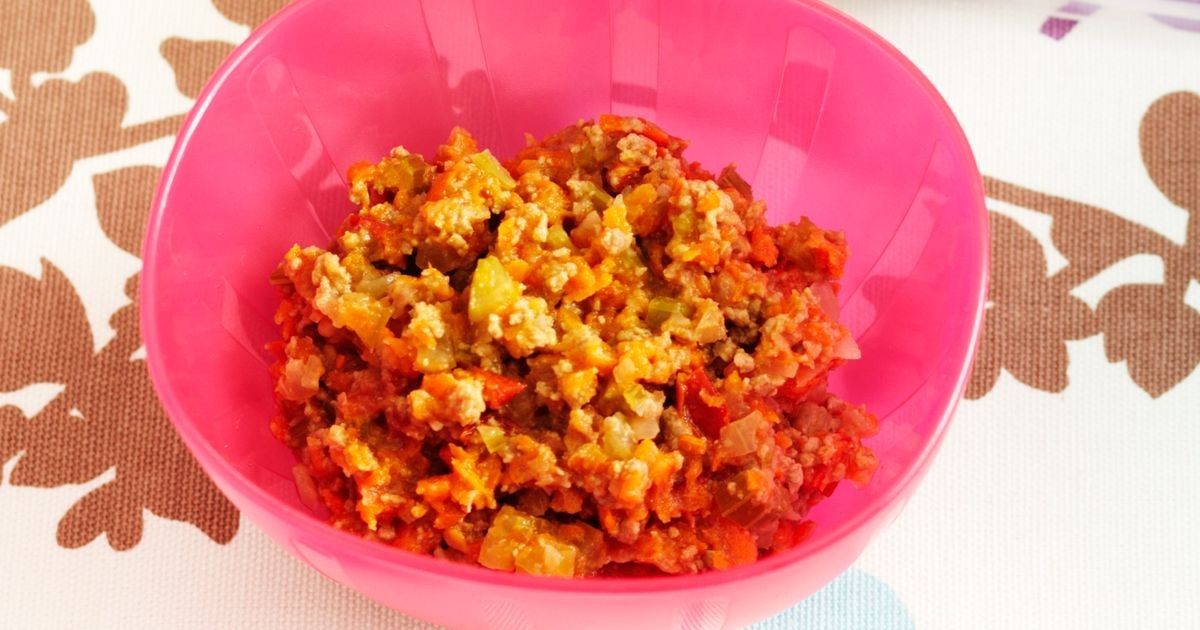 You only want to add broth if needed while blending. I had to add a 1/4 cup of broth to the blender while I was pureeing this chicken.
You only want to add broth if needed while blending. I had to add a 1/4 cup of broth to the blender while I was pureeing this chicken. - Reheat Gently: If you are freezing some of this chicken puree, reheat it in 20-second intervals. You don’t want to recook the chicken.
Puree Feeding Tips
- Trial adding a little seasoning or spice to purees – babies like flavor! Or consider changing the temperature of purees from time to time, to slightly warmed or slightly chilled. Varying these aspects adds to the sensory experience!
- Place a small amount of puree on the tray during spoon feeding, so that your baby can dip their fingers or hands in the puree. Allowing baby to explore foods in this way helps them learn to self-feed and can help them be more willing to try new textures and foods in the future.
- Have a spare spoon (or three!) – even very young babies often want to be involved in feeding themselves as much as possible.
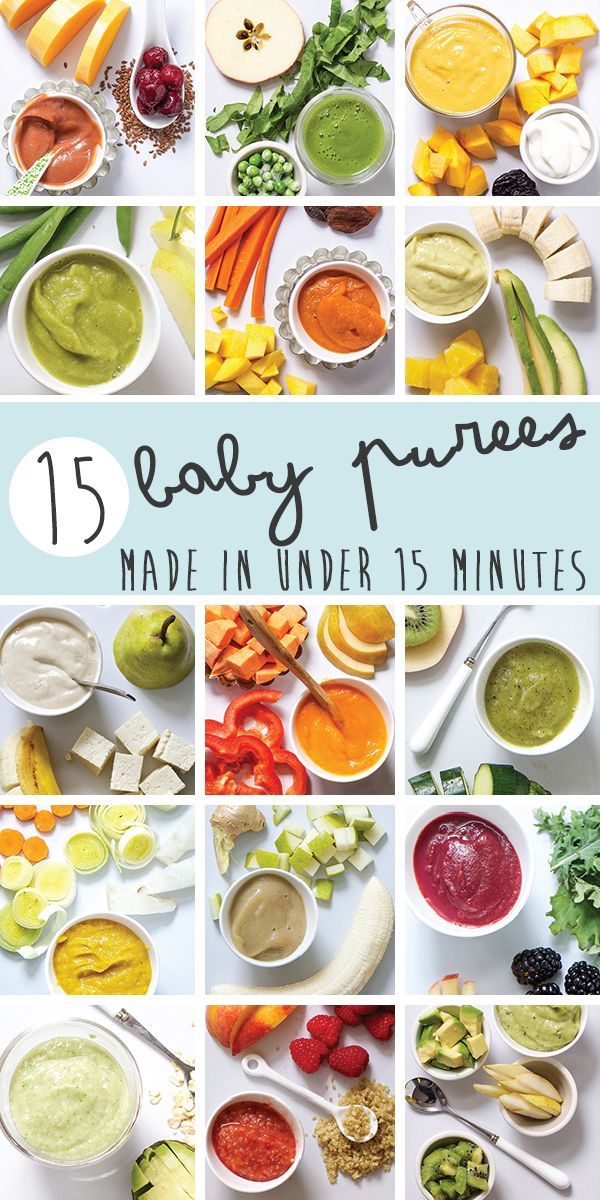 Giving baby an extra spoon to hold can be helpful in giving her a sense of control and also promotes hand-eye coordination.Allow baby to use spoons as a teether during the meal. There are many great options out there but a few we particularly love include the Olababy 3 Piece Set, the NumNum Pre-Spoon GOOtensils, and the ChooMee FlexiDip Baby Starter Spoons.
Giving baby an extra spoon to hold can be helpful in giving her a sense of control and also promotes hand-eye coordination.Allow baby to use spoons as a teether during the meal. There are many great options out there but a few we particularly love include the Olababy 3 Piece Set, the NumNum Pre-Spoon GOOtensils, and the ChooMee FlexiDip Baby Starter Spoons.
Or watch a shortened version of this video here.
- 1 8-ounce boneless skinless chicken breast or thighs, cubed
- 2 cups chicken or veggie stock, low-sodium or sodium-free
- 1 tsp dried parsley (optional)
Boil: In a medium saucepan, bring the cubed chicken, broth and parsley to a boil over medium heat.
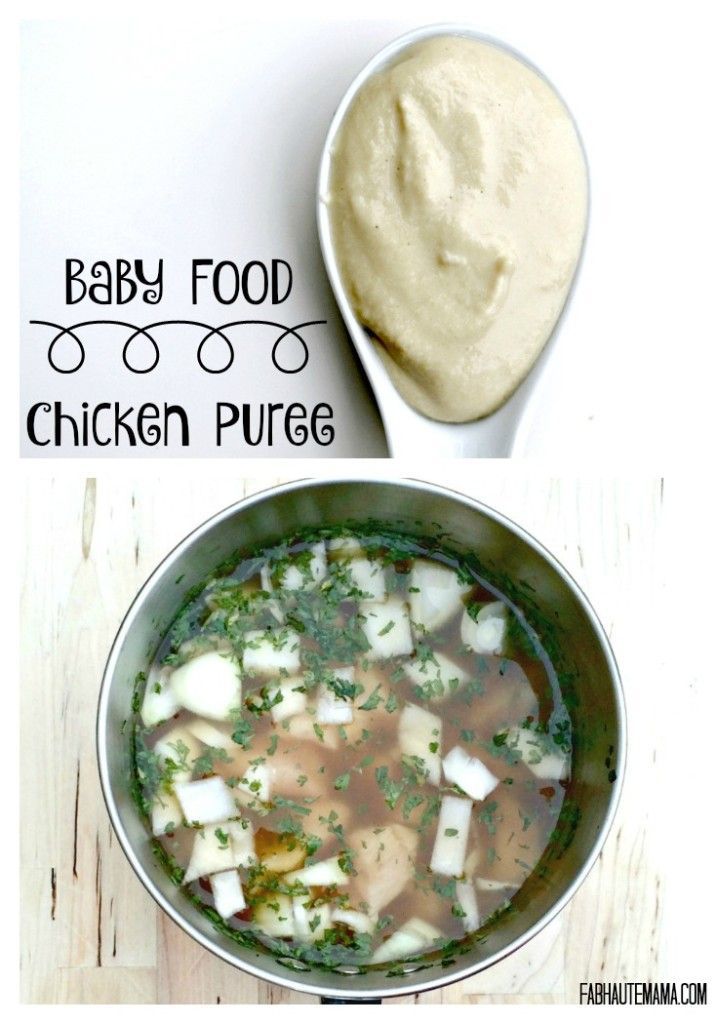
Simmer: Turn the heat down to low and simmer, covered, for 15 minutes or until chicken is just cooked through. Let cool slightly.
Transfer: Using a slotted spoon, transfer the chicken to a blender or food processor, leaving the broth in the saucepan. Reserve the broth
Puree: starting on low and working your way up to high-speed, puree the chicken until you reach your desired consistency, adding in broth in 1/4 cup increments if needed. I had to add in just 1/4 cup of broth to get the consistency seen in this photo.
Eat: serve to baby plain or added into another puree.
Freeze: store a small portion in the fridge and freeze the rest for another meal.
Extra Healthy Fat : For some extra healthy fat, this puree is also wonderful with a teaspoon of grass-fed butter (salt free) added to the blender right before pureeing.
Age: 4 months and up
Yield: roughly 12 ounces
Storage: Fridge – store in an airtight container in the fridge for 2-3 days. Freezer – can be frozen for up to 2 months (this and this are my favorite freezer storage containers).
Favorite Kitchen Tools: Get a list of my favorite kitchen tools to make the best baby food here!
Blender
Freezer Tray
Bumkins Baby Bowl
Grabease Utensil
Saucepan
Did you make this recipe?
Tag @babyfoode on Instagram and hashtag it #babyfoode!
Pin Recipe Email a Friend
How to cook meat puree for babies
About nutrition
- Photo
- Parents
Babies will not try baby meat puree until they are 7-8 months old.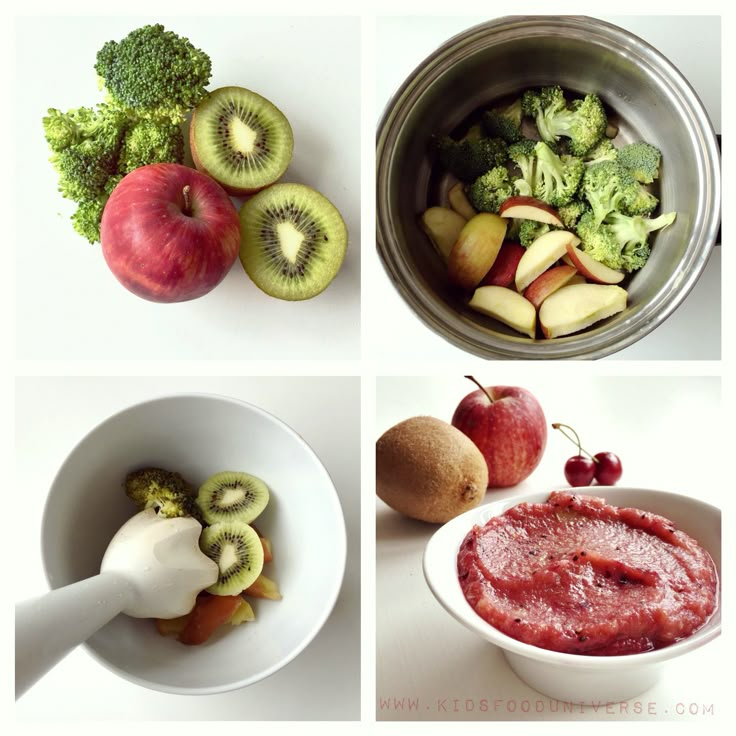 At this age, the child grows and develops intensively, and the iron reserves that he accumulated while he was in his mother's tummy and during breastfeeding are depleted in his body. It is during this period that it is recommended to introduce baby meat puree into his diet. Meat is the main source of complete animal protein, which is necessary for a growing man to protect against infections, normal development and formation of teeth and bones. Properly prepared meat puree for the first feeding contains easily digestible iron, phosphorus, potassium, magnesium, zinc, B vitamins. It also contains extractives that stimulate the production of digestive enzymes and the digestive system.
At this age, the child grows and develops intensively, and the iron reserves that he accumulated while he was in his mother's tummy and during breastfeeding are depleted in his body. It is during this period that it is recommended to introduce baby meat puree into his diet. Meat is the main source of complete animal protein, which is necessary for a growing man to protect against infections, normal development and formation of teeth and bones. Properly prepared meat puree for the first feeding contains easily digestible iron, phosphorus, potassium, magnesium, zinc, B vitamins. It also contains extractives that stimulate the production of digestive enzymes and the digestive system.
It is worth remembering the rules for the introduction of complementary foods. A new product is introduced gradually (over 5-7 days) starting with a small amount. It should be given in the morning to mark an unwanted reaction. Complementary foods are given from a spoon before breastfeeding or formula milk.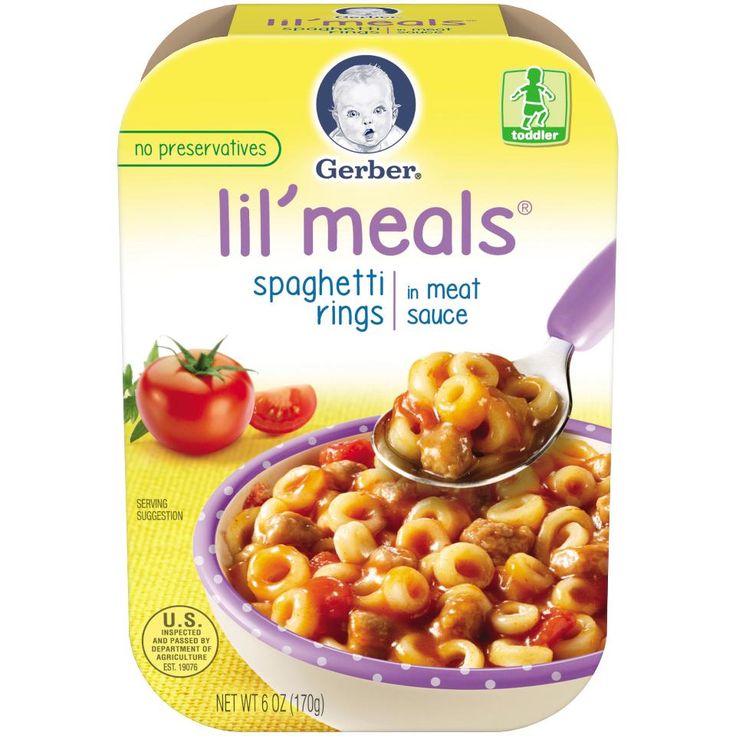
When feeding with mashed meat, start with a portion of 3–5 g (that’s 1/2 teaspoon), so that, gradually increasing its size, reach 60–80 g by 1 year. you can buy in the store, ready-made. Is it worth it to "fool around" with home cooking? It's up to you. There is no single answer to the question of which meat purees are best for your baby. But we think you will agree that a homemade recipe guarantees confidence in every ingredient. Yes, and cooking mashed potatoes at home is not difficult. 9Ol000
plastic or metal spoon
meat cutter
plastic cutting board (more hygienic, wood is more difficult to clean and germs can accumulate on it)
blender
actual piece of meat
1. Choosing meat
For the first feeding, it is recommended to choose hypoallergenic rabbit or turkey meat, which are easy to digest and contain little fat. Lamb and lean veal and beef are also not forbidden. Pork for babies will be too fatty and can cause a malfunction in the digestive system, chicken quite often causes allergic reactions.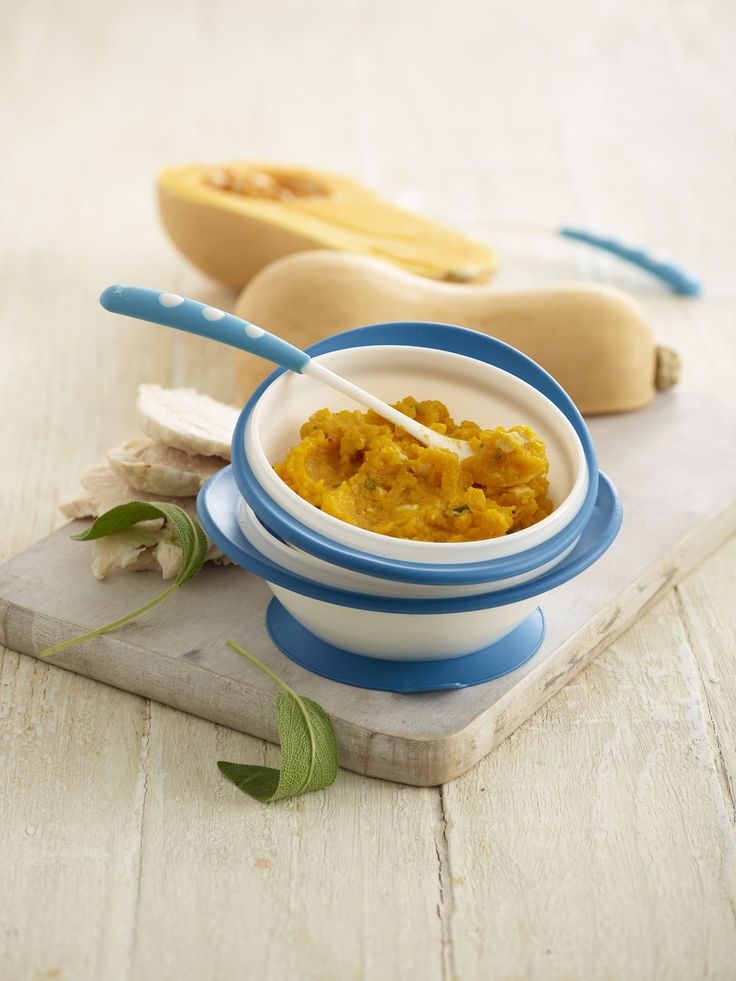
It is recommended to buy meat for baby meat puree in a trusted store. Since any meat must pass veterinary control, the seller must carry a certificate confirming this procedure. Give preference to whole cuts of meat (not in cubes), fresh and juicy in appearance, not weathered. The cut of a piece of meat should be even, pink. A dark red or whitish cut indicates that the meat was either stored incorrectly, or is far from the first freshness.
To help a mother who is worried about the question “what to feed her baby”, we have prepared a material “What to feed a baby: a baby’s nutrition diary from birth to a year”
- Photo
- Parents
2. Preparing meat
Before preparing the meat puree for the first feeding, it is necessary to thoroughly rinse the meat under running cold or warm water. Remove fat, veins, skin, films from it and free it from bones.
Then cut a piece of about 10 cm from the whole piece of meat. Meat puree, like other foods for babies, should not be stored. For this reason, at one time you will need a very small piece of meat. The remaining meat can be cut into larger pieces and put in the freezer. Just keep in mind that any food for babies can only be thawed once. A defrosted product cannot be re-frozen: temperature changes create a favorable environment for the reproduction of pathogens. So every time, intending to prepare meat puree for feeding, we take out 1 piece of meat from the freezer. For the first time, this amount is more than enough.
3. Rules for cooking meat for baby puree
Put the meat in a pot of cold water (remember, it must be filtered or bottled) and wait until it boils. After 5 minutes, drain the water (this is necessary to get rid of fat and extractives that make digestion difficult) and fill the meat with new water, it should cover it. Cook the meat until tender over low heat for about 2 hours (turkey, veal and lamb should be cooked until tender for 1-1. 5 hours). If the water boils away, add it again. And remember that kids do not need to salt and add spices to the meat.
5 hours). If the water boils away, add it again. And remember that kids do not need to salt and add spices to the meat.
Find out how to make a menu for a one-year-old baby here: “Almost an adult menu: what to feed a child from one to two years old”
- Photo
- Parents
cut it into small pieces. Then grind the pieces in a blender.
To make puree a homogeneous consistency, similar to thick porridge, add a few tablespoons of mixture or vegetable broth to it (meat broth is not allowed for babies!).
Ready-made meat puree can be mixed with vegetable puree, which is already familiar to the baby. So the child will more easily accept the new product. You can also pour a few drops of vegetable oil into the meat puree (7-month-old children are entitled to 5 ml).
The first serving of meat puree should be 0.5 teaspoon. Pay close attention to your child's reaction. If everything is in order, after a week you can increase the portion. By the year the child should already consume portions of 60-80 g of meat. It is best to feed baby meat puree at lunchtime.
Pay close attention to your child's reaction. If everything is in order, after a week you can increase the portion. By the year the child should already consume portions of 60-80 g of meat. It is best to feed baby meat puree at lunchtime.
Read also: “When a child begins to chew and how to prepare for this”
- photo
- Parents
Each mother has his own recipe for making meat puree for infants . We will present some of them.
Homemade meat puree for babies with beef
Needed: 40 g beef, water, 1 teaspoon butter
Cleaned meat, free of bones, membranes and sinews, cut into small pieces. Stew the pieces in a small amount of water until fully cooked, about 2 hours.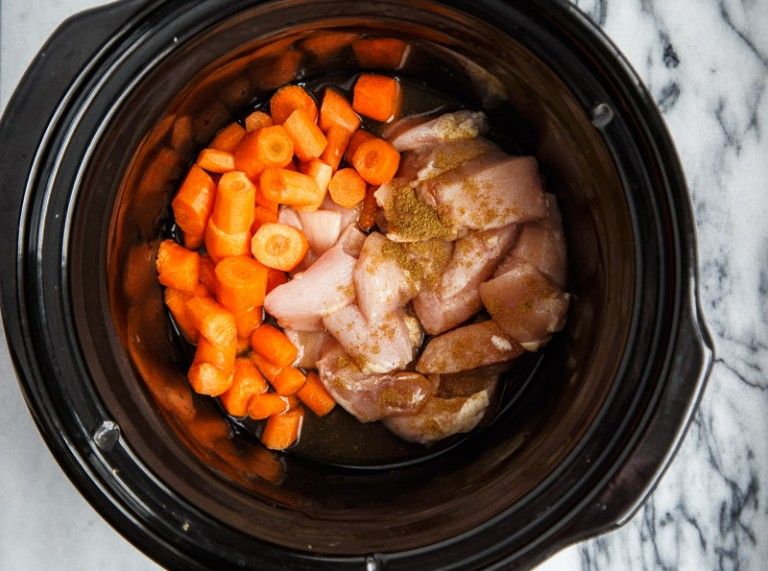 Cool the finished meat and scroll twice through a meat grinder, and then chop in a blender. This way you will achieve a uniform consistency. Add a little vegetable broth to the resulting puree and bring to a boil. Thoroughly mix everything, add butter.
Cool the finished meat and scroll twice through a meat grinder, and then chop in a blender. This way you will achieve a uniform consistency. Add a little vegetable broth to the resulting puree and bring to a boil. Thoroughly mix everything, add butter.
You can also add some breast milk to the meat puree. But in this case, boiling mashed potatoes is no longer required.
Turkey meat puree recipe
You will need: 100 g turkey fillet, 0.5 cup of water.
Meat can be cooked on the multicooker rack, steamed or boiled in a pot of water on the stove. We cook in a slow cooker by setting the “steam” mode for 40 minutes. We cut the boiled meat into pieces, which we grind with a blender until a homogeneous consistency is obtained. Dilute with water. Since the turkey puree is a little dry, you can pour a few drops of vegetable oil into it. Ready-made meat puree can not be stored in the refrigerator for more than a day.
How to choose the right meat puree for babies in the store? We sorted out the issue together with a nutritionist: "Ready-made meat puree for a baby: analysis of the composition" perfect for 8-10 month old baby.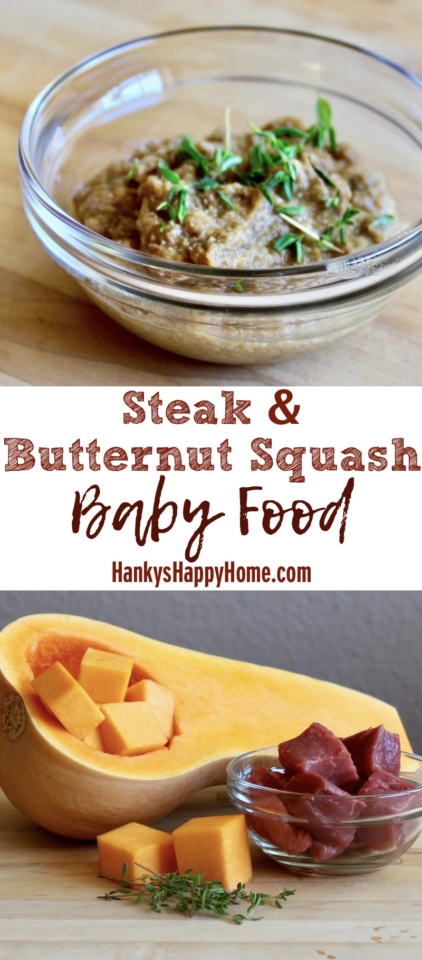 Moreover, one-component meat puree is a cheap way to make healthy food for your baby varied and interesting!
Moreover, one-component meat puree is a cheap way to make healthy food for your baby varied and interesting!
Mashed turkey is usually offered to the baby as a first meal. Remember that the first servings of meat puree should be no more than 30 grams. We also pay attention to the texture of the finished puree, it should be homogeneous without pieces and fibers. It is worth preparing the first turkey meat puree carefully so that the baby is impressed not only with taste, but also with a delicate texture. The first spoonful of meat puree determines whether the baby will like meat in the future or not.
A great and easy recipe to add some protein to your child's diet. It is necessary to boil the turkey meat, as we described in the article "How to prepare meat supplements", and then prepare a delicious turkey puree for the baby.
Serves: Serves
Instructions
-
Puree the cooked meat pieces in a blender until smooth.

-
Slowly add water to the puree, then stir until a homogeneous liquid consistency is obtained.
-
Add as much liquid as necessary to obtain a liquid consistency suitable for a child.
-
You can add vegetables or fruits to this puree if you like.
We are not afraid and add me to VK and Odnoklassniki, Instagram!
Like this article? Subscribe to site updates
"Encyclopedia Baby Food"!
Don't forget to bookmark us! (CTRL+SHIFT+D) Subscribe to the site, comment, share in social networks.
On our website Encyclopedia Baby Food there is useful information on the nutrition of your children, which is useful for everyone, and we update the website "Encyclopedia Baby Food" constantly and try to search and write only excellent, verified and necessary information for you and your children.
Disclaimer No. 1: It must be understood that the author of the articles on the Baby Food Encyclopedia website is not a medical staff, “I am not a doctor. ” The information I share is based on my own experience. My goal is not to teach you how to eat or feed your child, but to talk about how we did it, what new things I learned or read. This expands the picture of Baby Food knowledge, gives you a glimpse of the whole process so you can decide if you like it or not.
” The information I share is based on my own experience. My goal is not to teach you how to eat or feed your child, but to talk about how we did it, what new things I learned or read. This expands the picture of Baby Food knowledge, gives you a glimpse of the whole process so you can decide if you like it or not.
Disclaimer No. 2 : However, the above does not replace visiting a pediatrician. Before you start complementary foods, you need to get his professional opinion on the best way to introduce new foods for your baby. I also draw your attention to the fact that you need to look at the original date of the published articles, because some of the "best practices" may have changed. Always check with your child's pediatrician about complementary foods and their health.
Disclaimer #3: Keep in mind that every family is unique, every situation is also completely unique. There are no universal solutions. Only you can find what works best for you.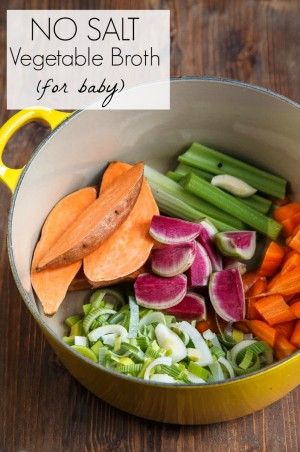 Certain goals require certain sacrifices and priorities - not everyone wants to make those choices, and that's GREAT! Just know what you want to achieve, and be ready to get to work, putting the best of your strength!
Certain goals require certain sacrifices and priorities - not everyone wants to make those choices, and that's GREAT! Just know what you want to achieve, and be ready to get to work, putting the best of your strength!
Disclaimer No. 4: On the Encyclopedia Baby Food website, photos from books on baby food with attribution are used to better understand the information (Article 1274, paragraph 1, part four of the Civil Code of the Russian Federation). Literature on baby food is found in the public domain on the Internet.
Apricot puree with chicken
Banan-global puree
Banana puree
borsch
Bousse broth with peas and rice
Botterbrod with kolrabi
Rapid dessert
Sine 20 Buckwheat porridge with apricots
Buckwheat porridge with banana
Buckwheat pilaf
Children's sausage
Children's milk porridge with banana
Children's vinaigrette
Children's ketchup
Children's cucumber salad
Children's salad Olivier
Children's porridge biscuits
Children's puree of strawberries, bananas, yellow cherries, yoghurt and biscuits with cereals
Children's puree with cottage cheese and fruits
Homemade yeast bread with flax flour
Homemade cheese
Homemade pizza
2 Breakfast outside Kohlrabi appetizer
Roasted cauliflower
Roasted carrots
Roasted carrots and cherries with millet
Winter salad with Jerusalem artichoke
Cabbage with white beans
Cabbage salad like in the canteen
Mashed potatoes
Quinoa and pumpkin porridge
Quinoa porridge
Breakfast cereals
Quinoa and apple
Strawberry puree
Strawberry puree with banana
Strawberry compote
Wild apple and raspberry compote
Thermo-steamed fruit compote for older children 8 months
Corn porridge
Corn porridge with pear
Corn porridge with pumpkin
Corn porridge with pumpkin and carrots
Corn porridge with apple and carrots
Chicken liver in the oven
Chicken cutlets with carrots
Chicken with carrots, sweet peppers and potatoes
Pasta navy
Macaroni with orange sauce
Macaroni with Gremolata
Muffins with vegetables and egg
New potatoes in their jackets
Milk vermicelli soup4 Carrot puree2-22 Carrot-rice casserole
Carrot with chicken
Fly agaric from eggs and tomatoes
Meat envelopes
Homemade Tarragon drink for children
Vegetable puree from cauliflower and carrots
Vegetable soup with corn semolina
Vegetable soup with cheese and corn semolina
Vegetable soup with spinach
Vegetable puree soup with bell pepper
Oatmeal porridge
Pollock fritters
Hot kefir fritters
Cauliflower omelette in 2 bags
Spinach and Cheese Omelette
Omelette Pancake
Peach Puree
Baked Apples 7 months +
Zucchini and Carrot Pie
Zucchini Pie
Rice and Zucchini Pie
Fish Pie
Fish and potato pie
White cabbage pizza
Lavash pizza
Zucchini, tomato and sausage pizza
Tomato and olive pizza
Spinach pizza
Rabbit pilaf
Chicken pilaf with green peas and 2 corn puree 904 and cherries
Banana, cottage cheese and porridge puree 4 cereals
Broccoli (cauliflower) puree
Broccoli, courgette and cauliflower puree
Blueberry puree
Pear puree
Pear and banana puree
Pear and banana puree, baked
Pear and pumpkin puree 7 months +
Pear, pumpkin and peach puree
Pear, apple, plum and prunes puree
Blackberry puree
Turkey puree
Zucchini puree 2 90 zucchini and broccoli
Zucchini, carrot and potato puree
Quinoa and banana puree
Quinoa and carrot puree
Quinoa, banana and carrot puree
Quinoa, squash and carrot puree
Quinoa, peach and raspberry puree
quinoa, cauliflower, apple, peas and mint
Quinoa, apple, pear and raisin puree
Quinoa, apple, carrot puree
Rabbit, broccoli and cauliflower puree
Chicken, carrot, potato, apple and pea puree
Raspberry, cherry and banana puree
carrots
Carrot and apple puree
Carrot, potato, broccoli puree with cheese
Carrot, potato, apple and quinoa puree
Carrot, pumpkin, apple and prunes puree
Carrot, apple and potato puree
Turnip and carrots
Plum puree
Cottage cheese, strawberry and banana puree
Pumpkin puree
Pumpkin and banana puree
Pumpkin and zucchini puree
Pumpkin and apple puree
Pumpkin, apple and banana puree
Cauliflower and broccoli puree
Cauliflower puree and potatoes
Cauliflower and rice puree
Cauliflower and apple puree
Cauliflower, green peas and squash puree
Cauliflower, turkey and potato puree
Cauliflower, potato and squash puree
Cauliflower, carrot and broccoli puree
Cauliflower, carrot, cheese and rice puree
Cauliflower, apple and courgette puree
Zucchini puree
Zucchini and potato puree
Zucchini, carrot and apple puree 90 cherries
Blueberry puree
Prune puree
Apple, pumpkin, carrot and some curry puree
Apple and pear puree
Apple and strawberry puree
Apple, strawberry and cherry puree
Apple, peach and banana puree
Carrot and pumpkin puree
Cottage cheese and banana puree
Turkey, potato and carrot stew
Zucchini, carrot and broccoli stew
Fish, potato, carrot and broccoli stew
Rice porridge
Whole grain rice porridge
carrot
Rice porridge with pumpkin
Rice porridge with apples
Rice porridge with apple and pear
Rice porridge with apple and pumpkin
Fish cakes with vegetables
Semi-cooked fish
Fish meatballs with ketchup
Baby Fish Soup
Salmon and Celery Fish Soup
Carrot and Kohlrabi Salad
Chickpea Salad
Chickpea and Cabbage Salad
The Laziest Soup
Creamy Kohlrabi Soup
Oatmeal Smoothie4 Sauce
Pea and Bacon Soup
Baked Vegetable Soup
Kohlrabi Soup
Salmon Soup
Cauliflower Soup
Turnip Potato Soup
Meatball Soup for the Picky Eater
Green apple kohlrabi soup
Rabbit, pumpkin, potato, broccoli and cauliflower soup
Beetroot soup
Pumpkin mushroom soup
Broccoli and celery soup
Soup/stew Pork with Potatoes and Carrots
Cheese Pasties
Pumpkin Cheese Sauce (Annabelle Carmel Recipe)
Buzz Lightyear Sandwich
Pumpkin Apple Puree
Pumpkin Apple Juice
Pumpkin Cake
Pumpkin Soup 9 Puree
Fruit Salad
2 Bread lavash
Cauliflower with cheese
Linden tea and thyme
Experimental soup-puree with vermicelli and lentils
Apple puree
Apple juice
Don't be afraid and add me to VK and Instagram, Odnoklassniki!
Like this article? Subscribe to site updates
"Encyclopedia Baby Food"!
Don't forget to bookmark us! (CTRL+SHIFT+D) Subscribe to the site, comment, share in social networks.
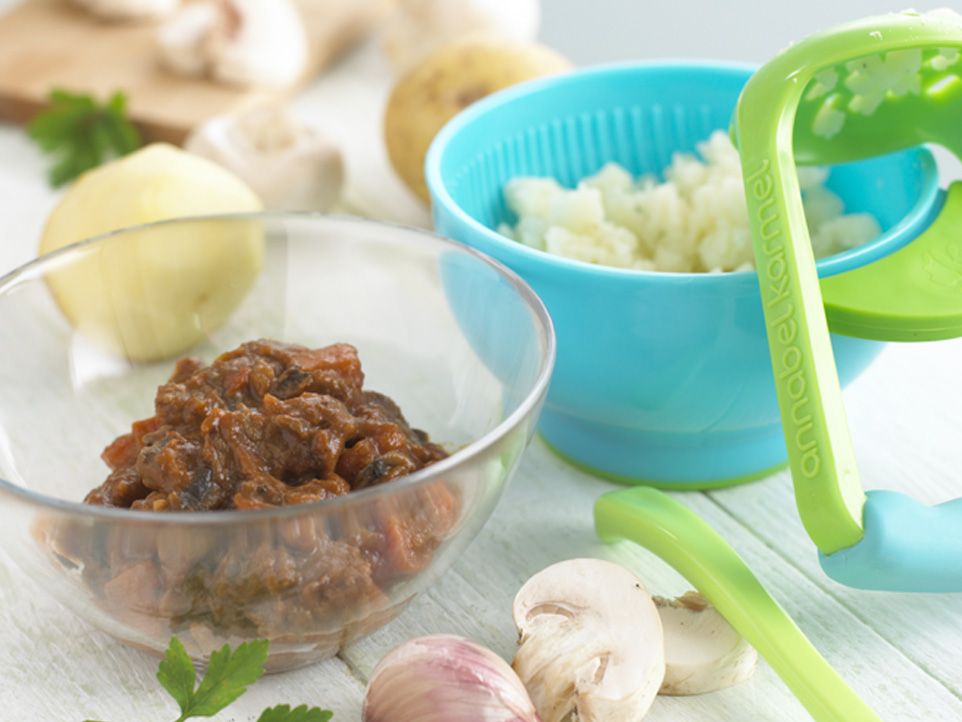
Our website Encyclopedia Baby Food has useful information on the nutrition of your children, which is useful for everyone, and we update the website "Encyclopedia Baby Food" constantly and try to search and write only excellent, verified and necessary information for you and your children.
Disclaimer No. 1: It must be understood that the author of the articles on the Baby Food Encyclopedia website is not a medical staff, “I am not a doctor.” The information I share is based on my own experience. My goal is not to teach you how to eat or feed your child, but to talk about how we did it, what new things I learned or read. This expands the picture of Baby Food knowledge, gives you a glimpse of the whole process so you can decide if you like it or not.
Disclaimer No. 2 : However, the above does not replace visiting a pediatrician. Before you start complementary foods, you need to get his professional opinion on the best way to introduce new foods for your baby. I also draw your attention to the fact that you need to look at the original date of the published articles, because some of the "best practices" may have changed. Always check with your child's pediatrician about complementary foods and their health.
I also draw your attention to the fact that you need to look at the original date of the published articles, because some of the "best practices" may have changed. Always check with your child's pediatrician about complementary foods and their health.
Disclaimer #3: Keep in mind that every family is unique, every situation is also completely unique. There are no universal solutions. Only you can find what works best for you. Certain goals require certain sacrifices and priorities - not everyone wants to make that choice, and that's GREAT! Just know what you want to achieve, and be ready to get to work, putting the best of your strength!
Disclaimer No. 4: On the Encyclopedia Baby Food website, photos from books on baby food with attribution are used to better understand the information (Article 1274, paragraph 1, part four of the Civil Code of the Russian Federation). Literature on baby food is found in the public domain on the Internet.

